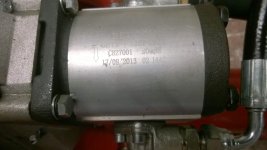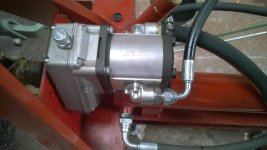I definataly got questions regarding the pump specs and actual flow. If the pump is rated for 2800RPM max, you are not going to be flowing nearly as much only running 1600rpm. So looking at a spec sheet would be helpful to us. As part of the formula for figuring out how much HP you need is GPM and PSI of the pump. And at this point, we know neither of those.
But "assuming" you are getting 9.25gpm and operating 2500PSI, that requires about 16HP. With a 30HP tractor, (probably around 24 at the PTO and a little less running through a gearbox) you should still have plenty of power for that flow and PSI.
So if you are stalling the engine (or nearly so), either you are making far more GPM than you think, or are generating more pressure than you think. Given that it is on the return stroke the only real pressure is when the cylinder reaches the end of the stroke. Most actual log splitter valves have a detent that kicks the valve to neutral one ~600psi is reached. It sounds like that isnt the case.
So aside from getting us more info on the pump specs, what is the make/model of the valve you are using? Is it spring return both ways? does it have the detent return? Does it stay in whatever position you put it in until you move it?
Some of the hose sizes are a little undersized as well, but shouldnt cause you to stall a 30hp tractor. Flowing 9.25 GPM 3/8" is a tad small. For pressure lines, 38" hose is good for 8-8.5gpm or so.
The return lines, when retracting the cylinder however, are trying to flow around 16GPM. which would want something in the 3/4" to 1" range.
But either way, regardless of hoses sizes, flow velocities, etc. If the pressure relief valve is set properly, there shouldnt be any stalling you your tractor. So whatever issue you have, is valve/pump related.
When splitting wood, it likely isnt taking as much pressure as you think. That is why you are only experiencing it when retracting and the cylinder bottoms out. Try extending the cylinder all the way till it bottoms out that direction and see if it is the same stalling situation.



